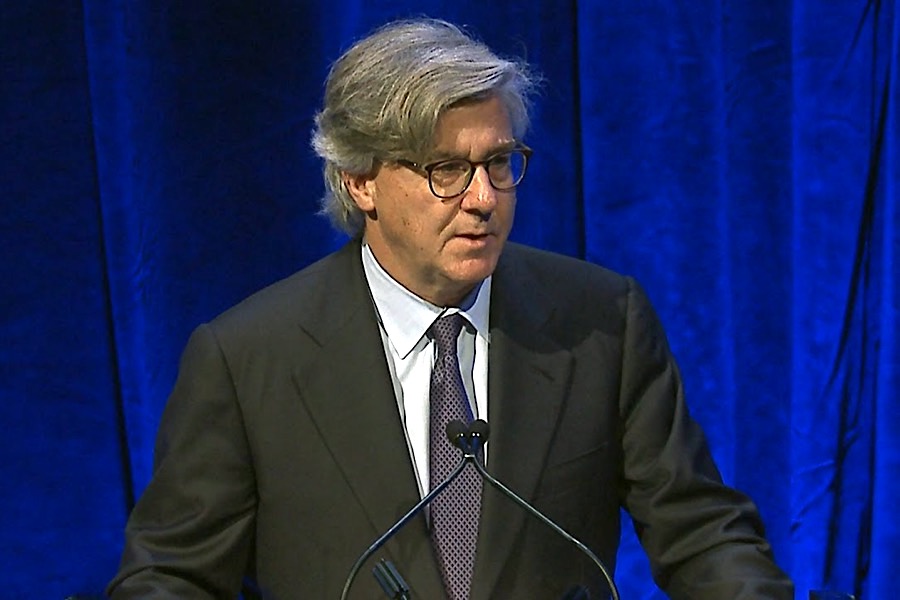
The man proposing to buy Newmont Mining Corp. in the world’s biggest gold takeover is the same person who was blamed for the deal falling apart five years ago — Barrick Gold Corp. Chairman John Thornton.
On Monday, Barrick went hostile in its bid to acquire Newmont in a $17.8 billion bid that values the Colorado-based gold miner at an 8 percent discount to Friday’s close. The offer was blasted by Newmont Chief Executive Officer Gary Goldberg, calling it a “desperate” and “bizarre” move by Barrick.
“What we’ve just seen here in the last day suggests that John is still firmly in control and trying to drive things the way he sees best,” Goldberg said in a Bloomberg TV interview Monday, referring to Thornton. If you compare total shareholder returns for the two companies since 2014, it is clear Barrick has “destroyed shareholder value,” he added.
Thornton was hand picked by Barrick founder Peter Munk to succeed him, but in a tight-knit Canadian mining community peppered with geologists as CEOs, his banking pedigree made him an outsider from the start.
A successful merger of Newmont and Barrick would combine the two biggest gold producers. Monday’s hostile bid makes one thing clear: despite the naysayers and critics who have challenged Thornton since he joined Barrick, his ambition remains unfettered.
Thornton is employing the same strategy with Newmont that he used with Randgold Resources Ltd. — a zero premium for the target company. Mark Bristow — who founded and helmed Randgold before becoming CEO of Barrick after the merger — has criticized the gold industry for “ undisciplined growth and poor returns,” vowing the “New Barrick” will be different. In contrast, Newmont offered a 17 percent premium for Goldcorp Inc. in January.
Barrick and Newmont have discussed merging many times, and came close in 2014. When those talks fell apart, Newmont pointed the finger squarely at Thornton, a former Goldman president who joined the industry in 2012. Newmont’s chairman at the time, Vincent Calarco, accused him of failing to demonstrate the “vision and values” needed for a successful partnership as the deal came undone.
“While our team has found your management team’s engagement to be constructive and professional, the same constructive nature cannot be said of our discussions with your co-chairman,” Calarco wrote of Thornton.
Among the reasons those negotiations broke down, Thornton was perceived as pushing too far in trying to become executive chairman of the merged company, according to people familiar with the talks who asked not to be identified because the discussions were private.
This time around, Toronto-based Barrick has amassed a small stake in Newmont and warned the Greenwood Village, Colorado-based company that it plans to propose changes to its bylaws, including a reduction in the amount of shares needed to call a special meeting at Newmont. Such a meeting could be used to vote out members of Newmont’s board.
The letter to Newmont’s board also said Barrick would call for the introduction of a bylaw that would stifle efforts by Newmont to improve its takeover defenses, according to people familiar with the matter.
Thornton “tried repeatedly” to engage Newmont around the synergies that could be worked out in Nevada, and he did that again just before Barrick announced its hostile bid, Bristow said Monday during a conference call with analysts. Bristow would remain CEO of the merged company, which can run the Nevada assets better than Newmont, he said in interviews from the conference.
Thornton was hand picked by Barrick founder Peter Munk to succeed him, but in a tight-knit Canadian mining community peppered with geologists as CEOs, his banking pedigree made him an outsider from the start. And his pay package raised hackles — investors managing almost a billion dollars in assets, banded together to fight him over compensation in 2013 calling his $11.9 million signing bonus “unprecedented” in Canada. It was the same year the company’s debt peaked at $15.8 billion.
Thornton would eventually yield to pay concerns, cutting his compensation by 76 percent.
Meanwhile, he was also cutting costs — and staff — to reduce Barrick’s debt. As the company’s share price bottomed in 2015 alongside gold prices, Thornton concentrated on forging relationships abroad, negotiating joint-venture partnerships, and opting for a deal to sell a stream — future output for upfront cash — from its core Pueblo Viejo mine in the Dominican Republic. That strategy allowed him to wring value out of the assets without selling them outright, Bristow said recently. “He really pushed the envelope on cash flow.”
In September, Thornton upstaged his fellow gold miners — including Newmont — at a gold conference in Colorado with news of a $5.4 billion deal for Randgold. Friday’s confirmation that he’s contemplating a “nil premium” purchase of Newmont not only would be his most audacious buy yet, it also also would threaten Newmont’s own blockbuster deal, announced last month, to spend $10 billion on Goldcorp.
Thornton is a polarizing figure but the Randgold merger has created almost instant value for shareholders, David Neuhauser, a managing director at Livermore Partners, which owns Barrick shares, said by phone. Whether a tie-up with Newmont would appease his critics, may take a few years to determine.
“You would need time to see if it vindicates him,” Neuhauser said. “He’s a guy that people tend to love or hate.”
(By Danielle Bochove)